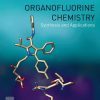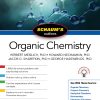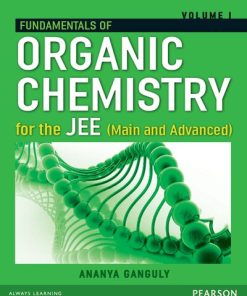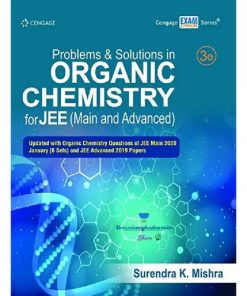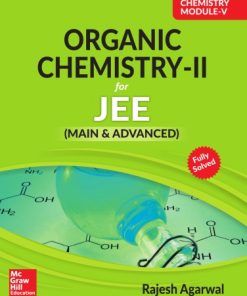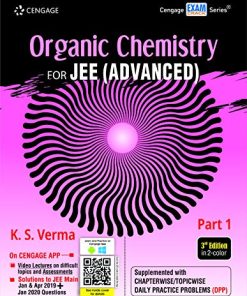(Ebook PDF) Wiley’s Solomons Fryhle and Snyder Organic Chemistry For Jee Main and Advanced 3RD Edition by MS Chouhan ISBN 9788126598328 8126598328 full chapters
$50.00 Original price was: $50.00.$25.00Current price is: $25.00.
(Ebook PDF) Wiley’s Solomons Fryhle and Snyder Organic Chemistry For Jee Main and Advanced 3RD Edition by MS Chouhan -Ebook PDF Instant Download/Delivery:9788126598328, 8126598328
Instant download Full Chapter of Wiley’s Solomons Fryhle and Snyder Organic Chemistry For Jee Main and Advanced 3RD Edition after payment
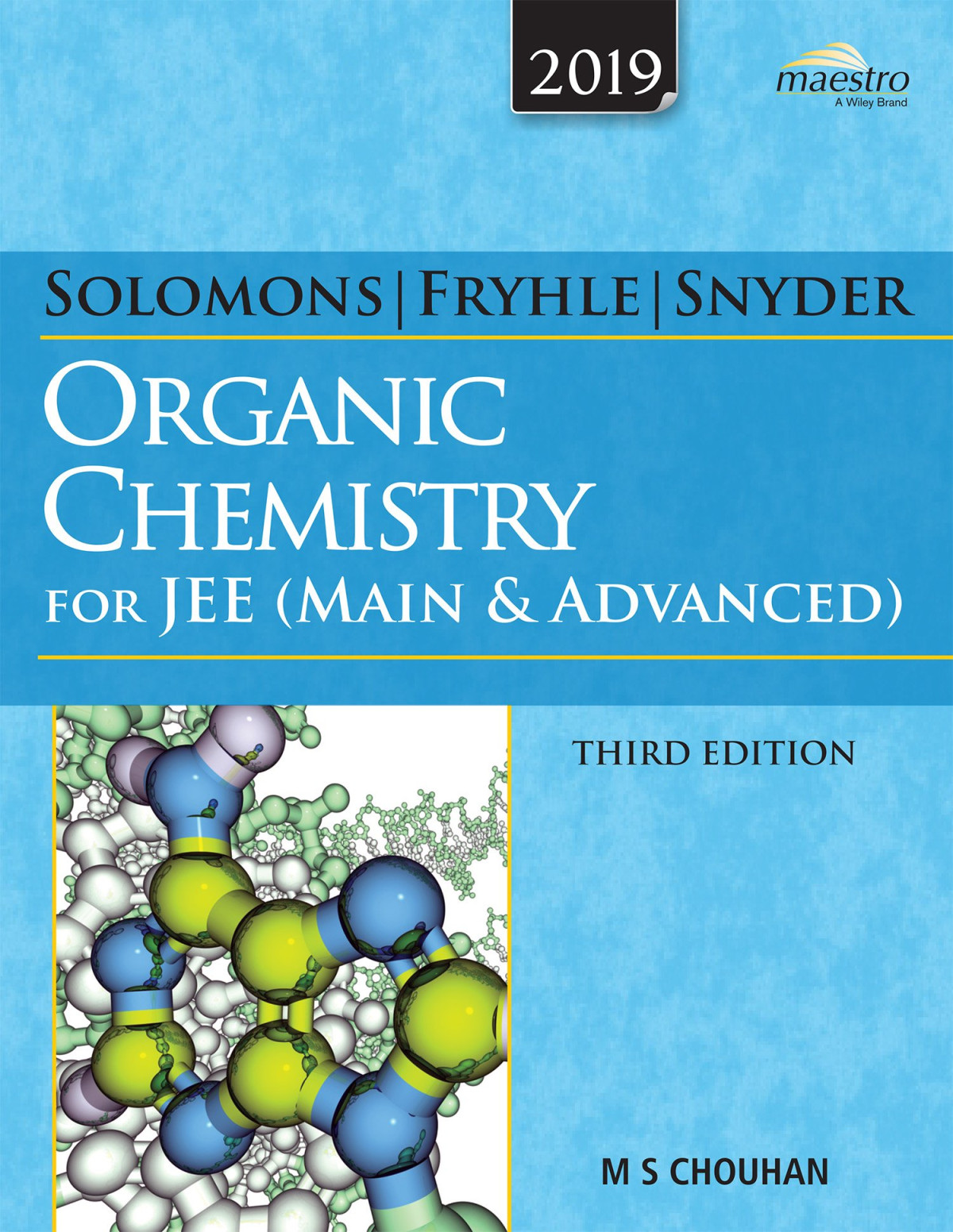
Product details:
ISBN 10:8126598328
ISBN 13:9788126598328
Author: MS Chouhan
This adapted version of one of the world’s most well-known books on Organic Chemistry combines the Solomons, Fryhle and Synder approach to Organic Chemistry with engineering entrance examinations requirements. The book has been reorganized based on the challenges faced by the students preparing for engineering entrance in terms of practice problems and clarity of theories. The relevance to exams is enhanced by elaborating concepts related to the syllabus, removing irrelevant topics and addition of specific problems at the end of each chapter.
Table of Contents:
- 1 The Basics: Bonding and Molecular Structure
- 1.1 Development of the Science of Organic Chemistry
- 1.2 Atomic Structure
- 1.3 The Structural Theory of Organic Chemistry
- 1.4 Chemical Bonds: The Octet Rule
- 1.5 Resonance Theory
- 1.6 Hyperconjugation
- 1.7 The Structure of Methane and Ethane: sp3 Hybridization
- 1.8 The Structure of Ethene (Ethylene): sp2 Hybridization
- 1.9 The Structure of Ethyne (Acetylene): sp Hybridization
- 1.10 How to Interpret and Write Structural Formulas
- 2 Families of Carbon Compounds: Functional Groups and Intermolecular Forces
- 2.1 Hydrocarbons: Representative Alkanes, Alkenes, Alkynes, and Aromatic Compounds
- 2.2 Polar and Nonpolar Molecules
- 2.3 Functional Groups
- 2.4 Alkyl Halides or Haloalkanes
- 2.5 Alcohols
- 2.6 Ethers
- 2.7 Amines
- 2.8 Aldehydes and Ketones
- 2.9 Carboxylic Acids, Esters, and Amides
- 2.10 Nitriles
- 2.11 Summary of Important Families of Organic Compounds
- 2.12 Physical Properties and Molecular Structure
- 2.13 Summary of Attractive Electric Forces
- 3 An Introduction to Organic Reactions and Their Mechanisms: Acids and Bases
- 3.1 Reactions and Their Mechanisms
- 3.2 Acid–Base Reactions
- 3.3 Lewis Acids and Bases
- 3.4 Heterolysis of Bonds to Carbon: Carbocations and Carbanions
- 3.5 HOW TO Use Curved Arrows in Illustrating Reactions
- 3.6 The Strength of Brønsted–Lowry Acids and Bases: Ka and pKa
- 3.7 HOW TO Predict the Outcome of Acid–Base Reactions
- 3.8 Relationships between Structure and Acidity
- 3.9 Energy Changes
- 3.10 The Relationship between the Equilibrium Constant and the Standard Free-Energy Change, DG°
- 3.11 The Acidity of Carboxylic Acids versus Alcohols
- 3.12 The Effect of the Solvent on Acidity
- 3.13 Organic Compounds as Bases
- 3.14 Acids and Bases in Nonaqueous Solutions
- 3.15 Acid–Base Reactions and the Synthesis of Deuterium- and Tritium-Labeled Compounds
- 3.16 Reaction of NaHCO3 as a Base
- 3.17 Steric Inhibition of Resonance (SIR) Effect
- 3.18 Ortho and Para Effects
- 4 Stereochemistry: Chiral Molecules
- 4.1 Chirality and Stereochemistry
- 4.2 Isomerism: Constitutional Isomers and Stereoisomers
- 4.3 Enantiomers and Chiral Molecules
- 4.4 A Single Chirality Center Causes a Molecule to Be Chiral
- 4.5 More about the Biological Importance of Chirality
- 4.6 HOW TO Test for Chirality: Planes of Symmetry
- 4.7 Naming Enantiomers: The R,S-System
- 4.8 Properties of Enantiomers: Optical Activity
- 4.9 The Origin of Optical Activity
- 4.10 The Synthesis of Chiral Molecules
- 4.11 Chiral Drugs
- 4.12 Molecules with More than One Chirality Center
- 4.13 Fischer Projection Formulas
- 4.14 Stereoisomerism of Cyclic Compounds
- 4.15 Relating Configurations through Reactions in which no Bonds to the Chirality Center are Broken
- 4.16 Separation of Enantiomers: Resolution
- 4.17 Compounds with Chirality Centers Other than Carbon
- 4.18 Chiral Molecules That Do Not Possess a Chirality Center
- 4.19 Biphenyl
- 4.20 Racemization of Biphenyl Compounds
- 4.21 Tautomerism
- 4.22 Gero Entropy
- 5 Nomenclature and Conformations of Alkanes and Cycloalkanes
- 5.1 Introduction to Alkanes and Cycloalkanes
- 5.2 Shapes of Alkanes
- 5.3 HOW TO Name Alkanes, Alkyl Halides, and Alcohols: The IUPAC System
- 5.4 HOW TO Name Cycloalkanes
- 5.5 HOW TO Name Alkenes and Cycloalkenes
- 5.6 HOW TO Name Alkynes
- 5.7 Physical Properties of Alkanes and Cycloalkanes
- 5.8 Sigma Bonds and Bond Rotation
- 5.9 Conformational Analysis of Butane
- 5.10 The Relative Stabilities of Cycloalkanes: Ring Strain
- 5.11 Conformations of Cyclohexane: The Chair and the Boat
- 5.12 Substituted Cyclohexanes: Axial and Equatorial Hydrogen Groups
- 5.13 Disubstituted Cycloalkanes: Cis–Trans Isomerism
- 5.14 Bicyclic and Polycyclic Alkanes
- 5.15 Chemical Reactions of Alkanes
- 5.16 Synthesis of Alkanes and Cycloalkanes
- 5.17 HOW TO Gain Structural Information from Molecular Formulas and the Index of Hydrogen Deficiency
- 5.18 Applications of Basic Principles
- 6 Ionic Reactions Nucleophilic Substitution and Elimination Reactions of Alkyl Halides
- 6.1 Alkyl Halides
- 6.2 Nucleophilic Substitution Reactions
- 6.3 Nucleophiles
- 6.4 Leaving Groups
- 6.5 Kinetics of a Nucleophilic Substitution Reaction: An SN2 Reaction
- 6.6 A Mechanism for the SN2 Reaction
- 6.7 Transition State Theory: Free-Energy Diagrams
- 6.8 The Stereochemistry of SN2 Reactions
- 6.9 The Reaction of tert-Butyl Chloride with Water: An SN1 Reaction
- 6.10 A Mechanism for the SN1 Reaction
- 6.11 Carbocations
- 6.12 The Stereochemistry of SN1 Reactions
- 6.13 Factors Affecting the Rates of SN1 and SN2 Reactions
- 6.14 Organic Synthesis: Functional Group Transformations Using SN2 Reactions
- 6.15 Elimination Reactions of Alkyl Halides
- 6.16 The E2 Reaction
- 6.17 The E1 Reaction
- 6.18 HOW TO Determine Whether Substitution or Elimination is Favored
- 6.19 Overall Summary
- 7 Alkenes and Alkynes I Properties and Synthesis. Elimination Reactions of Alkyl Halides
- 7.1 Introduction
- 7.2 The (E )–(Z ) System for Designating Alkene Diastereomers
- 7.3 Relative Stabilities of Alkenes
- 7.4 Cycloalkenes
- 7.5 Synthesis of Alkenes via Elimination Reactions
- 7.6 Dehydrohalogenation of Alkyl Halides
- 7.7 Acid-Catalyzed Dehydration of Alcohols
- 7.8 Carbocation Stability and the Occurrence of Molecular Rearrangements
- 7.9 The Acidity of Terminal Alkynes
- 7.10 Synthesis of Alkynes by Elimination Reactions
- 7.11 Terminal Alkynes can be Converted to Nucleophiles for Carbon–Carbon Bond Formation
- 7.12 Hydrogenation of Alkenes
- 7.13 Hydrogenation: The Function of the Catalyst
- 7.14 Hydrogenation of Alkynes
- 7.15 An Introduction to Organic Synthesis
- 8 Alkenes and Alkynes II Addition Reactions
- 8.1 Addition Reactions of Alkenes
- 8.2 Electrophilic Addition of Hydrogen Halides to Alkenes: Mechanism and Markovnikov’s Rule
- 8.3 Stereochemistry of the Ionic Addition to an Alkene
- 8.4 Addition of Water to Alkenes: Acid-Catalyzed Hydration
- 8.5 Alcohols from Alkenes through Oxymercuration– Demercuration: Markovnikov Addition
- 8.6 Alcohols from Alkenes through Hydroboration–Oxidation: Anti-Markovnikov Syn Hydration
- 8.7 Hydroboration: Synthesis of Alkylboranes
- 8.8 Oxidation and Hydrolysis of Alkylboranes
- 8.9 Summary of Alkene Hydration Methods
- 8.10 Protonolysis of Alkylboranes
- 8.11 Electrophilic Addition of Bromine and Chlorine to Alkenes
- 8.12 Stereospecific Reactions
- 8.13 Halohydrin Formation
- 8.14 Oxidation of Alkenes: Syn 1,2-Dihydroxylation
- 8.15 Oxidative Cleavage of Alkenes
- 8.16 Electrophilic Addition of Bromine and Chlorine to Alkynes
- 8.17 Addition of Hydrogen Halides to Alkynes
- 8.19 HOW TO Plan a Synthesis: Some Approaches and Examples
- 8.18 Oxidative Cleavage of Alkynes
- 8.20 Dimerization of Alkene
- 8.21 Prins Reaction
- 9 Radical Reactions
- 9.1 Introduction: How Radicals Form and How they React
- 9.2 Homolytic Bond Dissociation Energies (DH °)
- 9.3 Reactions of Alkanes with Halogens
- 9.4 Chlorination of Methane: Mechanism of Reaction
- 9.5 Halogenation of Higher Alkanes
- 9.6 Reactions that Generate Tetrahedral Chirality Centers
- 9.7 Allylic Substitution and Allylic Radicals
- 9.8 Benzylic Substitution and Benzylic Radicals
- 9.9 Radical Addition to Alkenes: The Anti-Markovnikov Addition of Hydrogen Bromide
- 9.10 Other Important Radical Reactions
- 10 Alcohols and Ethers Synthesis and Reactions
- 10.1 Structure and Nomenclature
- 10.2 Physical Properties of Alcohols and Ethers
- 10.3 Synthesis of Alcohols from Alkenes
- 10.4 Reactions of Alcohols
- 10.5 Alcohols as Acids
- 10.6 Conversion of Alcohols into Alkyl Halides
- 10.7 Alkyl Halides from the Reaction of Alcohols with Hydrogen Halides
- 10.8 Alkyl Halides from the Reaction of Alcohols with PBr3 or SOCl2
- 10.9 Tosylates, Mesylates, and Triflates: Leaving Group Derivatives of Alcohols
- 10.10 Rearrangements
- 10.11 Synthesis of Ethers
- 10.12 Reactions of Ethers
- 10.13 Epoxides
- 10.14 Reactions of Epoxides
- 10.15 Anti 1,2-Dihydroxylation of Alkenes via Epoxides
- 10.16 Crown Ethers
- 11 Alcohols from Carbonyl Compounds
- 11.1 Structure of the Carbonyl Group
- 11.2 Oxidation–Reduction Reactions in Organic Chemistry
- 11.3 Alcohols by Reduction of Carbonyl Compounds
- 11.4 Oxidation of Alcohols
- 11.5 Organometallic Compounds
- 11.6 Preparation of Organolithium and Organomagnesium Compounds
- 11.7 Reactions of Organolithium and Organomagnesium Compounds
- 11.8 Alcohols from Grignard Reagents
- 11.9 Lithium Dialkylcuprates: The Corey–Posner, Whitesides–House Synthesis
- 12 Conjugated Unsaturated Systems
- 12.1 Introduction
- 12.2 Alkadienes and Polyunsaturated Hydrocarbons
- 12.3 1,3-Butadiene: Electron Delocalization
- 12.4 Electrophilic At tack on Conjugated Dienes: 1,4-Addition
- 12.5 The Diels–Alder Reaction: A 1,4-Cycloaddition Reaction of Dienes
- 13 Aromatic Compounds
- 13.1 The Discovery of Benzene
- 13.2 Nomenclature of Benzene Derivatives
- 13.3 Reactions of Benzene
- 13.4 The Kekulé Structure for Benzene
- 13.5 The Thermodynamic Stability of Benzene
- 13.6 Modern Theories of the Structure of Benzene
- 13.7 Hückel’s Rule: The 4n + 2 o Electron Rule
- 13.8 Other Aromatic Compounds
- 13.9 Heterocyclic Aromatic Compounds
- 14 Reactions of Aromatic Compounds
- 14.1 Electrophilic Aromatic Substitution Reactions
- 14.2 A General Mechanism for Electrophilic Aromatic Substitution
- 14.3 Halogenation of Benzene
- 14.4 Nitration of Benzene
- 14.5 Sulfonation of Benzene
- 14.6 Friedel–Crafts Alkylation
- 14.7 Friedel–Crafts Acylation
- 14.8 Limitations of Friedel–Crafts Reactions
- 14.9 Synthetic Applications of Friedel–Crafts Acylations: The Clemmensen and Wolff–Kishner Reductions
- 14.10 Substituents Can Affect Both the Reactivity of the Ring and the Orientation of the Incoming Group
- 14.11 How Substituents Affect Electrophilic Aromatic Substitution: A Closer Look
- 14.12 Reactions of the Side Chain of Alkylbenzenes
- 14.13 Alkenylbenzenes
- 14.14 Synthetic Applications
- 14.15 Allylic and Benzylic Halides in Nucleophilic Substitution Reactions
- 14.16 Reduction of Aromatic Compounds
- 15 Aldehydes and Ketones I. Nucleophilic Addition to the Carbonyl Group
- 15.1 Introduction
- 15.2 Nomenclature of Aldehydes and Ketones
- 15.3 Physical Properties
- 15.4 Synthesis of Aldehydes
- 15.5 Synthesis of Ketones
- 15.6 Nucleophilic Addition to the Carbon–Oxygen Double Bond
- 15.7 The Addition of Alcohols: Hemiacetals and Acetals
- 15.8 The Addition of Primary and Secondary Amines
- 15.9 The Addition of Hydrogen Cyanide: Cyanohydrins
- 15.10 The Addition of Ylides: The Wittig Reaction
- 15.11 Oxidation of Aldehydes
- 15.12 The Baeyer–Villiger Oxidation
- 15.13 Chemical Analyses for Aldehydes and Ketones
- 16 Aldehydes and Ketones II. Aldol Reactions
- 16.1 The Acidity of the ` Hydrogens of Carbonyl Compounds: Enolate Anions
- 16.2 Keto and Enol Tautomers
- 16.3 Reactions via Enols and Enolates
- 16.4 Aldol Reactions: Addition of Enolates and Enols to Aldehydes and Ketones
- 16.5 Crossed Aldol Condensations
- 16.6 Cyclizations via Aldol Condensation
- 16.7 Lithium Enolates
- 17 Carboxylic Acids and Their Derivatives
- 17.1 Introduction
- 17.2 Nomenclature and Physical Properties
- 17.3 Preparation of Carboxylic Acids
- 17.4 Acyl Substitution: Nucleophilic Addition–Elimination at the Acyl Carbon
- 17.5 Acyl Chlorides
- 17.6 Carboxylic Acid Anhydrides
- 17.7 Esters
- 17.8 Amides
- 17.9 Derivatives of Carbonic Acid
- 17.10 Decarboxylation of Carboxylic Acids
- 17.11 Chemical Tests for Acyl Compounds
- 17.12 Summary of the Reactions of Carboxylic Acids and Their Derivatives
- 18 Amines
- 18.1 Nomenclature
- 18.2 Physical Properties and Structure of Amines
- 18.3 Basicity of Amines: Amine Salts
- 18.4 Preparation of Amines
- 18.5 Reactions of Amines
- 18.6 Reactions of Amines with Nitrous Acid
- 18.7 Replacement Reactions of Arenediazonium Salts
- 18.8 Coupling Reactions of Arenediazonium Salts
- 18.9 Reactions of Amines with Sulfonyl Chlorides
- 18.10 Synthesis of Sulfa Drugs
- 18.11 Eliminations Involving Ammonium Compounds
- 18.12 The Cope Elimination
- 18.13 Summary of Preparations and Reactions of Amines
- 19 Phenols and Aryl Halides
- 19.1 Structure and Nomenclature of Phenols
- 19.2 Naturally Occurring Phenols
- 19.3 Physical Properties of Phenols
- 19.4 Synthesis of Phenols
- 19.5 Reactions of Phenols as Acids
- 19.6 Other Reactions of the O—H Group of Phenols
- 19.7 Cleavage of Alkyl Aryl Ethers
- 19.8 Reactions of the Benzene Ring of Phenols
- 19.9 The Claisen Rearrangement
- 19.10 Quinones
- 19.11 Aryl Halides and Nucleophilic Aromatic Substitution
- 20 Carbohydrates
- 20.1 Introduction
- 20.2 Monosaccharides
- 20.3 Mutarotation
- 20.4 Glycoside Formation
- 20.5 Other Reactions of Monosaccharides
- 20.6 Oxidation Reactions of Monosaccharides
- 20.7 Reduction of Monosaccharides: Alditols
- 20.8 Reactions of Monosaccharides with Phenylhydrazine: Osazones
- 20.9 Synthesis and Degradation of Monosaccharides
- 20.10 The d Family of Aldoses
- 20.11 Fischer’s Proof of the Configuration of d-(+)- Glucose
- 20.12 Disaccharides
- 20.13 Polysaccharides
- 20.14 Other Biologically Important Sugars
- 20.15 Sugars that Contain Nitrogen
- 20.16 Carbohydrate Antibiotics
- 21 Amino Acids and Proteins
- 21.1 Introduction
- 21.2 Amino Acids
- 21.3 Synthesis of `-Amino Acids
- 21.4 Polypeptides and Proteins
- 21.5 Primary Structure of Polypeptides and Proteins
- 21.6 Secondary, Tertiary, and Quaternary Structures of Proteins
- 22 Carbene and Carbenoids
- 22.1 Introduction
- 22.2 Existence of carbenes
- 22.3 Formation of Carbenes
- 22.4 Types of Carbenes
- 22.5 Reactions of Carbenes
- 22.6 Rearrangement in Carbenes
- 23 Reactions of Nitrene and Electron Deficient Oxygen
- 23.1 Migration to Electron Deficient Nitrogen
- 23.2 Nitrene Formation
- 23.3 Hofmann—Curtius—Lossen—Schmidt Group of Rearrangements
- 23.4 Curtius Reaction
- 23.5 Schmidt Reaction
- 23.6 Hofmann-Bromamide Reaction or Hofman Rearrangement
- 23.7 Beckmann Rearrangement
- 23.8 Stieglitz Rearrangement
People also search:
wiley’s solomons fryhle & snyder organic chemistry for jee
is solomons and fryhle good for jee advanced
is solomons and fryhle good for jee
organic chemistry questions for jee mains
wiley’s solomons fryhle & snyder organic chemistry for jee pdf
Tags:
Wileys Solomons,Fryhle,Snyder Organic Chemistry,MS Chouhan
You may also like…
Chemistry - Organic Chemistry
Fundamentals of Organic Chemistry for the JEE – Vol I (Main and Advanced) Ananya Ganguly
Education Studies & Teaching - Studying & Test Preparation
Chemistry Module II Physical Chemistry II for IIT JEE (main and advanced) 1st Edition
Education Studies & Teaching - Studying & Test Preparation
Problems and Solutions in Organic Chemistry for JEE (Main and Advanced) 3rd Edition
Mathematics - Analysis
Integral Calculus for JEE Main and Advanced 3rd Edition Vinay Kumar
Chemistry - Organic Chemistry
Mathematics - Differential Equations
Uncategorized


